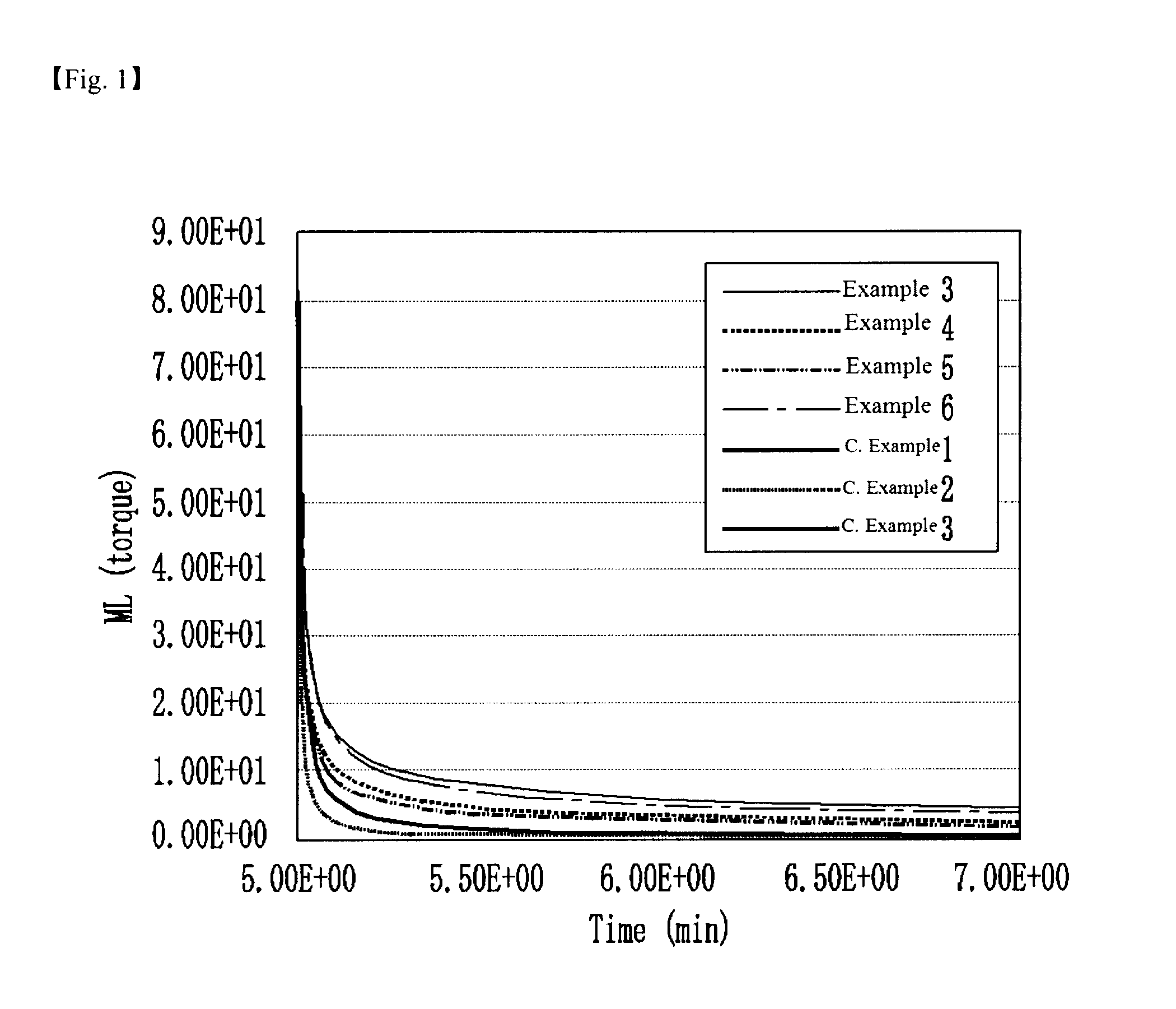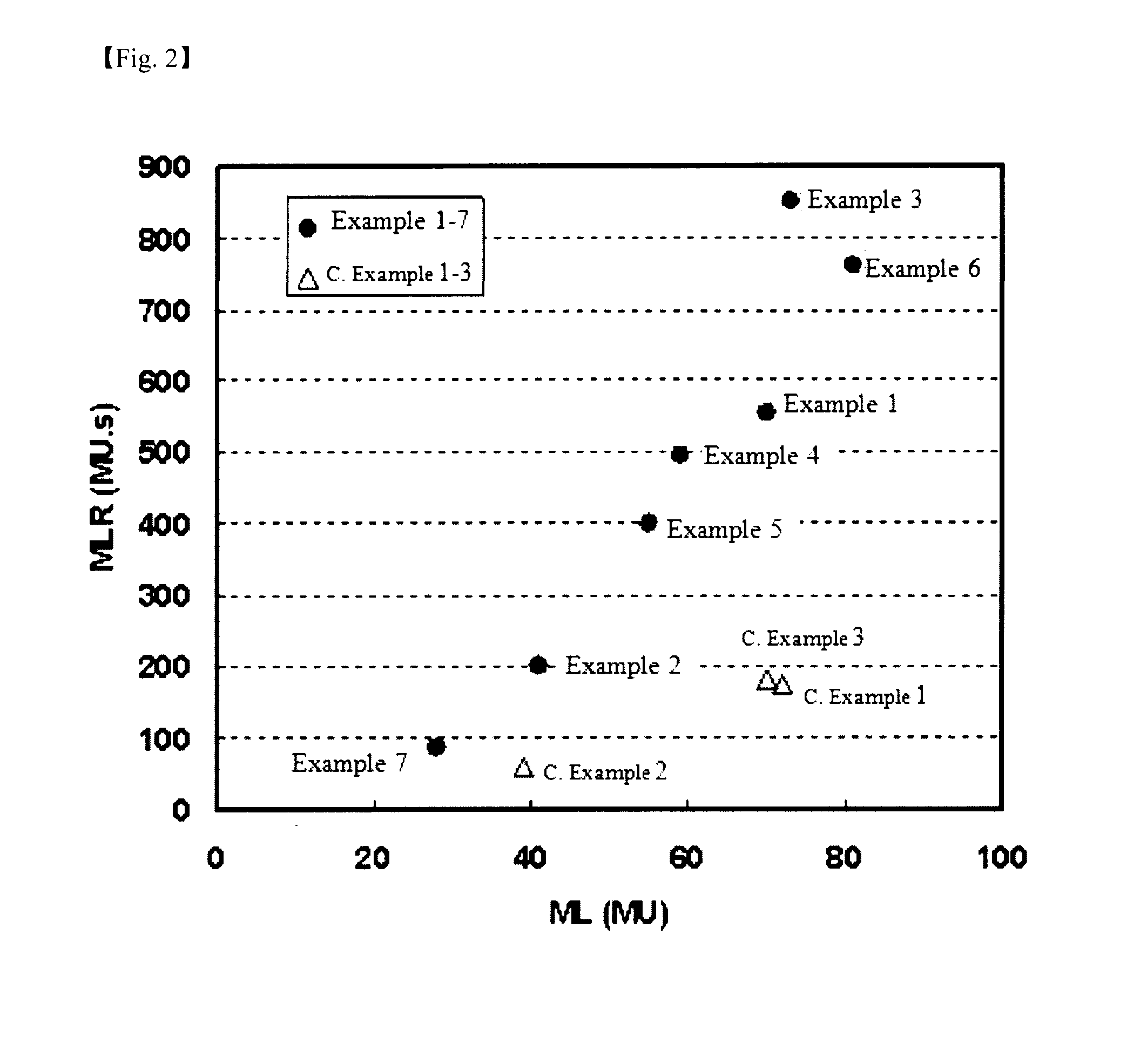Elastic terpolymer including diene group and preparation method thereof
a technology of terpolymer and diene, which is applied in the field of elastic terpolymer, can solve the problems of heat resistance deterioration, impurity generation, and increase of residual metal content of terpolymer, and achieve excellent processability, high productivity, and improved elasticity and flexibility
- Summary
- Abstract
- Description
- Claims
- Application Information
AI Technical Summary
Benefits of technology
Problems solved by technology
Method used
Image
Examples
examples 1 to 7
Preparation of the Elastic Terpolymer of Ethylene, Propylene, and 5-ethylidene-2-norbornene
[0091]The copolymerization reaction of ethylene, propylene, and 5-ethylidene-2-norbornene was continuously carried out by using a 2 L pressure reactor. Hexane, as a polymerization solvent, was continuously fed to the reactor through the bottom with the feeding speed of 6.7 kg per hour, and the polymerized solution was continuously taken out through the upper part.
[0092]As the first and second transition metal compounds, said [(1,2,3,4-tetrahydroquinolin-8-yl)tetramethylcyclopentadienyl-eta5,kapa-N]titanium dimethyl and [(2-methylindolin-7-yl)tetramethylcyclopentadienyl-eta5,kapa-N]titanium dimethyl were used in the form of being dissolved in hexane, and they were fed to the reactor with the feeding speed of 24 to 60 μmol per hour. As the cocatalyst compound, said N,N-dimethylanilinium tetrakis(pentafluorophenyl)borate was used in the form of being dissolved in toluene, and it was fed to the re...
experimental example 1
Measurement on the Mooney viscosity and the Mooney Relaxation Area (MLR)
[0098]The Mooney viscosity and the MLR were measured by using a Mooney viscometer (MV 2000 device model of Monsanto Co.) according to ASTM D1646-04. The sample was prepared by treating the terpolymer sample with an antioxidant (Irganox 1076) and making the same into a sheet by using a press mold. The sample was treated at 125° C. with a 1+4+2 condition by preheating the same for 1 min, measuring the Mooney viscosity for 4 min, and measuring the Mooney relaxation for 2 min.
[0099]MLR is the integration value of the Mooney stress relaxation during 2 min from when 1 s has passed after the rotor stopped, and the calculation equation may be represented by the following General Equation 2.
MLR=kα+1[t[n+1]-1]M=MooneyViscometertorque(MU)k=interceptα=slopet=measuringtime[GeneralEquation2]
[0100]The graphs of the Mooney relaxation curve and the MLR / ML to the ML of the terpolymers of the examples and the comparative examples ...
experimental example 2
Garvey-Die Extrusion Test
[0105]The extrusion processability was evaluated by a Garvey die extrusion test according to ASTM 2230. The samples for the Garvey die extrusion test were prepared as follows. 100 parts by weight of the elastic terpolymers prepared in Examples 1 and 2 and Comparative Examples 1 and 2, 75 parts by weight of paraffin oil, 125 parts by weight of carbon black, 5 parts by weight of ZnO, and 1 part by weight of stearic acid were mixed by using a 1.6 L Banbury mixer of Farrell Co. with a rotor speed of 60 rpm for 6 min at 100 to 120° C. The mixtures were extruded through the Garvey die extruder at a die temperature of 105° C. by varying the rotor speed to 45 or 60 rpm, and the surface and edge characteristics were evaluated. The results of the Garvey die test of Examples 1 and 2 and Comparative Examples 1 and 2 are listed in Table 3, and the photographs of the surface of the Garvey die extrudates of the elastic terpolymers of Example 1 and Comparative Example 1 are...
PUM
| Property | Measurement | Unit |
|---|---|---|
| weight % | aaaaa | aaaaa |
| weight % | aaaaa | aaaaa |
| weight % | aaaaa | aaaaa |
Abstract
Description
Claims
Application Information
 Login to View More
Login to View More - R&D
- Intellectual Property
- Life Sciences
- Materials
- Tech Scout
- Unparalleled Data Quality
- Higher Quality Content
- 60% Fewer Hallucinations
Browse by: Latest US Patents, China's latest patents, Technical Efficacy Thesaurus, Application Domain, Technology Topic, Popular Technical Reports.
© 2025 PatSnap. All rights reserved.Legal|Privacy policy|Modern Slavery Act Transparency Statement|Sitemap|About US| Contact US: help@patsnap.com



